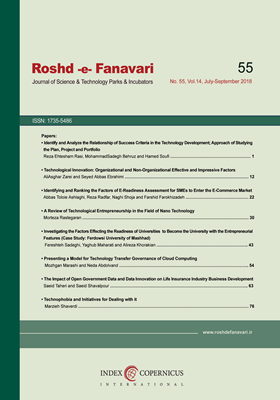Presenting a Model for Technology Transfer Governance of Cloud Computing
Subject Areas : انتقال فناوري و تجاريسازي پژوهشmozhgan marashi 1 , neda abdolvand 2
1 -
2 -
Abstract :
In recent years, developing countries have followed the use of technological advances and technology transfer of cloud computing is one of these innovations. Using innovations in the domain of information technology enables organizations to improve their economic status. As a result, it is necessary for organizations to learn how to manage their process of technology transfer. Technology transfer governance is a new concept that can help organizations in this area. Implementation of technology transfer governance can reduce costs and increase productivity For Organizations and facilitate the progress of organizations towards a competitive advantage. In the scope of new technologies such as cloud computing that success and acceptance needs to overcome the challenges and risks that it is facing, Governance transfer processes of this technology can reduce these challenges. As a result, the use of cloud computing can be extended in organizations and organization will benefit from this extention. Current research objective is fundamental and the methodology used is qualitative–descriptive in which the Library Studies are conducted to collect information. Results of research is presentation of two models of governance.in presentation of these models the COBIT framework is used as an efficient and strong governance framework in the field of information technology. The first proposed model is for technology transfer governance and the second model for technology transfer governance of cloud computing


